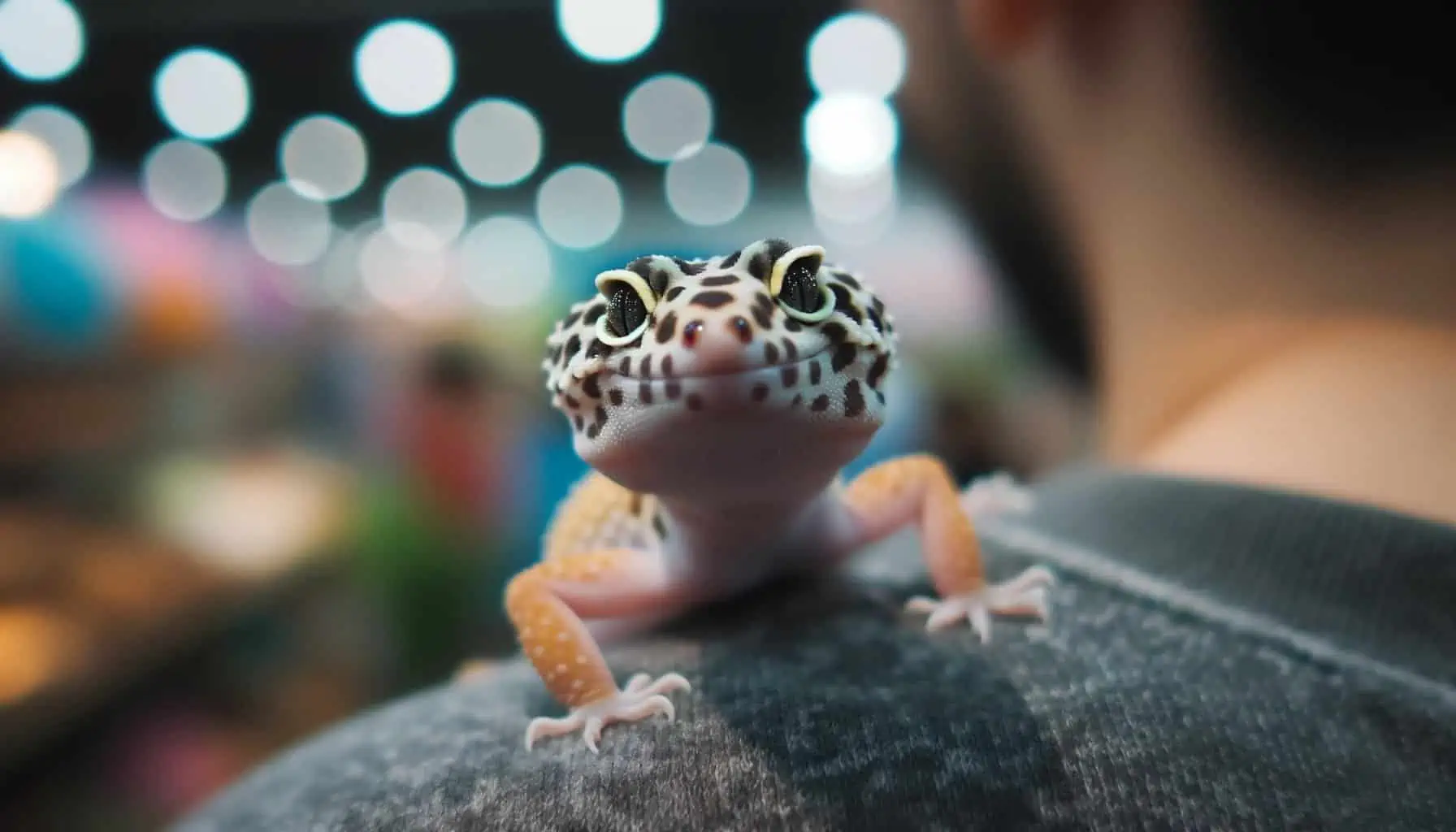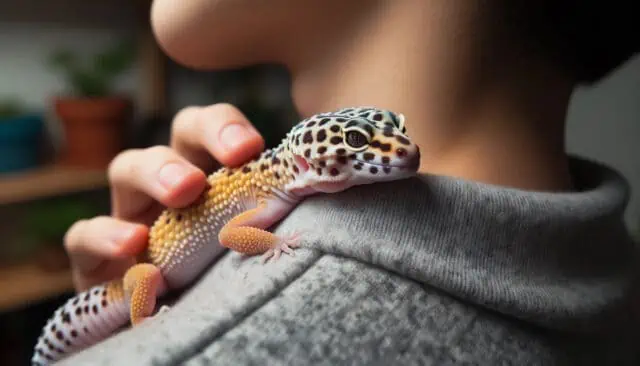Leopard geckos can sit on your shoulder, but their behavior and preference vary. Some might be comfortable resting there for a while, while others might prefer the safety of your hand. Understanding their individual behaviors and signs is essential when interacting with them.
Leopard Gecko’s Comfort: A secure and comfortable gecko may opt to sit on your shoulder. Some may prefer the flat and warm surface of your hand.
Signs of Stress: Look out for tail vibrations, hissing, or biting as indications of stress or agitation, suggesting the gecko needs space.
Handling Techniques: Use gentle and secure grips while handling the gecko, whether placing it on your shoulder or returning it to its enclosure. Always provide support to its body and tail.
Safety First: If the gecko attempts to run, calmly approach it without abrupt movements, always respecting its boundaries for a healthy relationship.
Behavioral Cues: Signs of a content gecko include a relaxed posture, subtle tail movements, and calm blinking. Recognizing these cues can help you understand when your gecko feels at ease.
Will a Leopard Gecko Sit On Your Shoulder?
Leopard geckos are unique creatures with distinct behaviors and preferences. When it comes to sitting on a shoulder, their behavior can vary based on individual personality, past experiences, and comfort level.
Leopard geckos, by nature, are ground-dwelling creatures. When placed on a shoulder, some might feel comfortable and stay still, while others might become restless or anxious. There are potential challenges and risks to be aware of. The gecko might get startled by sudden movements or sounds, potentially causing it to jump or fall. Additionally, it’s crucial to be cautious about where you move or walk with a gecko on your shoulder to prevent any accidents.
Some leopard geckos may show a clear preference for sitting on the hand instead of the shoulder. The hand offers a flatter, more familiar surface and may feel safer to them. Additionally, hands typically provide more warmth than clothing on the shoulder, which can be comforting to the cold-blooded reptile.
Training a leopard gecko to sit on your hand involves patience and consistency. Here are some tips:
- Start by letting the gecko get used to your presence. Sit by their enclosure regularly and speak softly.
- Introduce your hand slowly into their enclosure, letting them explore and get used to it.
- Offer treats when they approach or climb onto your hand. This reinforces the behavior.
- Over time, they’ll associate your hand with positive experiences and will be more inclined to stay there. Don’t associate smiles with positive reactions, it might not have any connection.
Introducing the concept of positive reinforcement is crucial in training. When the gecko behaves in a desired manner, like sitting calmly on your hand, reward it with a treat. This could be a favorite insect or a gentle petting. Over time, the gecko will associate the positive action with a reward, making the training process smoother.
How Long Will Leopard Geckos Sit On Your Shoulder
The duration a leopard gecko chooses to sit on your shoulder can vary widely based on several factors. Primarily, their behavior and individual preferences play a significant role in determining this period.
Typically, some leopard geckos might find solace on a person’s shoulder and choose to rest there for extended periods, sometimes even up to an hour. Their comfort can be attributed to the warmth they feel or the bond they share with their owner. On the other hand, there are geckos that might only tolerate being on a shoulder for a few minutes before showing signs of restlessness.
It’s crucial to be observant and understand the signs your gecko displays. Monitoring their behavior and body language is essential. Signs of discomfort might include fidgeting, rapid breathing, or trying to move away. When these signs are evident, it’s a clear indicator that it might be time to let them return to their familiar environment.
How To Place A Leopard Gecko On Your Shoulder: Step by Step
Handling a leopard gecko requires a gentle touch and understanding of their comfort levels. Placing them on your shoulder is a process that should be approached with care and patience.
Step 1. Gentle Removal From The Tank
The first step in handling your leopard gecko involves a gentle removal from its tank. Begin by slowly opening the cage, ensuring you don’t startle the gecko with abrupt movements. With an outstretched hand, approach the gecko calmly. It’s not uncommon for the gecko to be hesitant or scared initially. If this happens, patience is key. Repeat the process, allowing the gecko to become accustomed to your hand’s presence.
Once the gecko seems more at ease, you can gently slide your hand under its chin. This gesture is a non-threatening way to encourage the gecko to crawl into your hand. As it does, maintain a steady and calm demeanor. Once the gecko is securely in your hand, ensure you sit down slowly, minimizing any sudden movements that might stress the animal.
Step 2. Hold The Gecko For a Bit
After the initial step of removing the leopard gecko from its tank, it’s essential to hold it in your hands for a brief period. This time allows the gecko to adjust to the warmth and feel of your hands. Holding the gecko in this manner offers a chance to build trust and familiarity between you and the creature.
It’s worth noting that some geckos may show a distinct preference for staying on the hand. This behavior can be attributed to the hand’s flat surface and warmth, which might feel more secure to them than the shoulder. If you observe that your gecko is content on your hand, it’s a sign of their comfort.
To further encourage the gecko to remain calm and settled on your hand, consider offering treats as a form of positive reinforcement.
Step 3. Placing The Gecko On Your Shoulder
Placing the leopard gecko on your shoulder is a delicate process that prioritizes the gecko’s comfort and safety. It’s essential to ensure the gecko feels secure during this transition, as any sense of threat or discomfort can lead to stress for the animal.
Begin by sitting in a quiet and safe environment, minimizing distractions and potential disturbances. With the gecko comfortably resting in your hand, slowly bring it closer to your shoulder. Use your other hand to gently guide and support the gecko’s body. As you do this, ensure that you’re handling the gecko with care, avoiding any sudden movements.
Once the gecko is near your shoulder, allow it to crawl and explore the area at its own pace. It might take a few moments for the gecko to feel secure enough to fully settle on your shoulder. Throughout this process, it’s vital to remain patient and attentive to the gecko’s cues.
Step 4. Climbing or Leaping: How to Handle It
Leopard geckos are naturally curious creatures, and when on your shoulder or arm, they might exhibit climbing behavior or even attempt to leap. Handling such behaviors requires attentiveness and care to ensure the gecko’s safety.
To start, always ensure you have a secure grip on the gecko without squeezing or causing discomfort. Their claws are adept at climbing, so allow them to use these naturally grippy tools. This ensures they have a stable hold, reducing the risk of unexpected jumps or falls.
Despite your best efforts, there might be moments when the gecko feels the urge to leap or climb more vigorously. In such instances, it’s crucial to supervise them closely. Being attentive allows you to anticipate their moves and provide a safe surface for them to climb on or transfer them back to a more secure position.
Step 5. Don’t Over Do It: It May Stress It Out
Handling and interacting with your leopard gecko can be a delightful experience. However, it’s essential to remember not to overdo these handling sessions. Leopard geckos, like many reptiles, require their own space and time to relax. Excessive handling can introduce undue stress, which isn’t beneficial for the gecko.
Stress in leopard geckos can manifest in several ways. You might notice changes in their appetite, a shift in their normal behavior, or even physical signs like shedding problems. Prolonged stress can have negative effects on the gecko’s overall health and well-being. For instance, a stressed gecko might become more susceptible to illnesses or might not thrive in its environment.
Step 6. Placing the Leopard Gecko Back In The Tank
Concluding your handling session with a leopard gecko requires a careful placement process back into its tank. Ensuring a safe transition for your pet is paramount to prevent any stress or injury.
Begin by gently removing the gecko from your shoulder. It’s advisable to use both hands to securely hold the gecko, supporting its body and tail. This ensures that the gecko feels safe and is less likely to squirm or become anxious.
Once you have a firm yet gentle grip, slowly lower your hands into the tank. Instead of releasing the gecko abruptly, allow it to sense its familiar surroundings. Given a moment, the gecko will typically begin to crawl off your hands, transitioning smoothly onto the tank floor. This method ensures the gecko feels in control, reducing potential stress from the change in environment.
Handling Leopard Geckos Safely
When it comes to handling leopard geckos, ensuring their safety and comfort is of utmost importance. These delicate creatures require a gentle touch and understanding to prevent any potential injuries. Whether you’re a seasoned gecko owner or a beginner, knowing the right techniques can make a significant difference in your interactions with your pet.
One of the foundational aspects of handling is maintaining a secure grip on the gecko. It’s essential to hold them in a way that offers stability without being too tight. Applying excessive pressure or squeezing can cause distress or even physical harm to the gecko. Instead, focus on supporting the gecko’s body, ensuring that both its torso and tail are adequately held. This approach minimizes the risk of the gecko slipping or getting injured.
Despite all precautions, there might be moments when the gecko becomes startled and tries to run. One common concern among gecko owners is the fear of losing their pet in the house.
If your gecko does take off, remain calm. Quickly but carefully approach the gecko, using your hands to guide it gently without causing panic. It’s essential to act promptly but without sudden movements that might further scare the gecko.
Knowing When To Let Him Be: Behavior and Body Language
Understanding the behavior and body language of a leopard gecko is crucial in determining when it’s time to interact and when to give it some space. Just like humans, geckos communicate their feelings and moods through various physical cues and behaviors.
A stressed or agitated gecko will display distinct signs. Tail vibration is a common behavior indicating agitation or a warning. Additionally, hissing is a clear sign of discomfort or threat (they’re quiet usually), and in more severe cases, a gecko might resort to biting if it feels particularly threatened or cornered. Recognizing these signs early on helps prevent stress and ensures your safety as well.
On the other hand, a comfortable gecko exhibits a relaxed body posture. Its movements are more deliberate, and you might observe gentle tail movements that aren’t aggressive. Calm blinking and a lack of sudden, jerky motions further indicate that the gecko is at ease in its environment or with the handler.
However, even when your gecko appears content, it’s essential to respect its boundaries. Just as we need our alone time, geckos too benefit from periods of solitude to rest and rejuvenate. Always ensure you’re observing and respecting boundaries, giving your gecko the space it needs when it signals for it.







